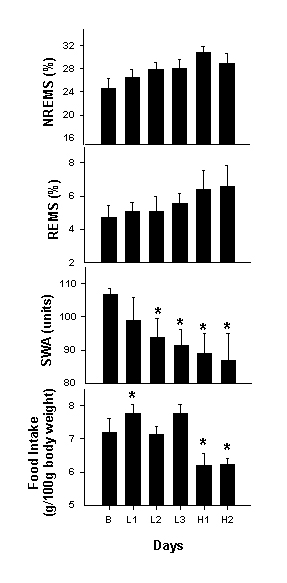Kate Stroup and Levente
Kapás
Introduction: There is a well-established relationship between feeding and sleep. Excessive eating by cafeteria diet (1) or refeeding after starvation (2) increases sleep in rats. Sleep has also been shown to affect levels of protein metabolism on a 24-hour cycle (3). Although the metabolic determinants of feeding and sleep have been investigated, the effect of a protein-rich diet on sleep has not yet been studied. The aim of the present experiment was to examine the effects of various protein-rich diets on sleep in rats. Methods: Male Sprague-Dawley rats (380-490 g) were implanted with EEG and EMG electrodes. The rats were kept on a 12:12 h light-dark cycle, light onset at 1000 h. On the two control days, rats (n = 8) were fed standard diet (LM-485 Mouse/Rat Diet, Harlan Teklad, Madison, WI), followed by 3 days of a 20% protein diet and 2 consecutive days of a 40% protein diet. At dark onset, all cages were cleaned of leftover food, and fresh food was provided. Recordings were conducted every day, from dark onset to dark onset. Results: As
the diet increased in protein content, there was a strong tendency towards
increased dark-phase REM and NREM sleep during the dark phase, but the
changes did not reach significance. There were statistically significant
decreases in dark-phase NREM sleep intensity on the second and third 20%
protein diet days, as well as both 40% protein diet days. On the
baseline days, food intake averaged 7.17 ± 0.33 g/100 g bw.
On the first 20% protein day, rats had significantly increased food intake,
and on both 40% protein days, food intake was significantly lower than
baseline. The average daily food intake on the 3 days of 20% protein
diet was 7.54 ± 0.22 g/100 g bw (not significant difference from
baseline). The average daily food intake on the two 40% protein days
was 6.21 ± 0.22 g/100 g bw, significantly below the food intake
on both baseline and 20% protein days. Although the rats’ net intake
of 40% protein diet was lower than the 20% protein diet, a daily average
of 69.8% more protein was consumed on 40% protein days than on 20% protein
days.
Conclusions: All of the experimental diets were equal in calorie count. The variations in protein significantly match trends in food intake and NREM sleep intensity, suggesting that the suppressed slow-wave activity could be due to higher levels of consumed protein. The changes in NREM and REM sleep amounts are only tendencies. Possibly further increases in protein intake could elicit more pronounced sleep changes. The slight increases in NREMS after 20% and 40% diet likely do not serve a homeostatic need. It is possible that decreases in SWA are due to a homeostatic compensatory mechanism caused by the excess amount of (‘luxury’) NREMS. References:
Support: Research
supported by NIH (NS-30514).
|
